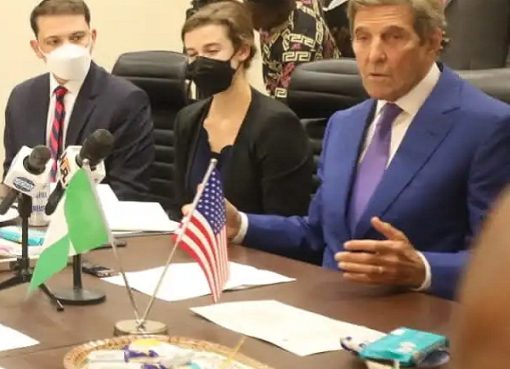Abdullahi Maidamu, 12, was badly cut in a boat mishap. He was returning home to Malale, Borgu Local Government Area, Niger State, with three of his siblings, from a farm across the river, when their boat developed a fault midway into the two-hour journey.
Sudden heavy downpour and turbulent waves overturned their boat. But the operator and his brothers rescued him and his sister.
He said, “As I tried to find my bearing, a tree stump cut through my leg. The pain was so severe, I thought I would die as Iya Ramat and my sisters did.”
For one hour after the accident, Abdullahi switched from stump to stump for support, as the waves recklessly slapped him, before help eventually came.
After two weeks with no improvement at a patent medicine store in Tungan Nailo, his father took him to the dispensary in Malale. The facility, not well-equipped, is what habitants of the 16 communities in Malale Ward, rely on.
Abdullahi and his father, Umar, travelled 17 kilometres from Tungan Nailo, a community downstream of Kainji Dam for treatment in Malale.
Upon arriving at River Niger, his father, carrying him on his back, deftly guided him to his right shoulder and eventually to face him, beckoning on the boat operator, Hamisu Wawa, to help lower Abdullahi into the boat.
Annually, these communities along with 45 others across seven wards downstream of Kainji Dam, are threatened by flood, heavy downpour and activities of the dam.
Although they frolic with the hydropower, only six communities enjoy electricity. They all lack water, access roads and medical facilities.
In Malale, Usabatu Muhammad, 16, and a herd of cattle arrived at different points of the river simultaneously. They all went in knee dip, drinking directly from it, just as water vendors fetched some, for sale in the community.
Usabatu sells food to boat operators and passengers commuting to neighbouring communities.
Her mother, Aisha, 47, and two siblings – Maimuna, 9, and Fatima, 12, – died in a 2015 boat accident in the same river. Regardless, the river is where she raises money every holiday to pay her school fees. The JSS 3 student desires to become a nurse, to assist victims of the yearly floods.
Eight major rivers – Niger, Kaduna, Gbako, Eko, Gurara, Ebba, Mariga – and their tributaries traverse Niger, making it disaster prone.
Borgu’s Emir, Alhaji Muhammad Dantoro, Kitoro IV, said Kainji Dam is considered the most important hydro-electric power plant in the country with a 760 megawatt generating capacity.
However, its establishmentin 1968 came with a steep price for host communities in Borgu and Yauri emirates.
The Niger State Emergency Management Agency (NSEMA) said the project displaced 44,000 inhabitants in the upstream, who were also forced to abandon their ancestral land through what experts call “forced evacuation” but authorities tag “resettlement.” They were resettled in New Bussa, Yelwa, Wawa, Nasarawa, Shagunu, Sabo Pegi and Monai.
Like Kainji, the construction of Jebba Dam in 1985, displaced 6, 000 from 42 villages. They were resettled in 21 locations in the hinterland known as Jebba villages within the Lake Basin.
The construction inundated about 950 hectares of land from New Bussa to Jebba. Settlements along the shoreline that were 102meters below sealevel were merged and resettled into new communities further inland.
Similarly, the construction of Shiroro Dam with a 600 megawatt generating capacity, displaced 36 communities.
Forfeiting ancestral lands among others came with high expectations and optimism that the projects would further enhance their fortune.
Danjuma Iliya’s family abandoned their family burial ground.
“We do not know what happened to the corpses after we left. We couldn’t exhume them to the new site,” he lamented. The family shrine was also lost to the hydropower project.
Haliru Suleiman in New Bussa, said most of the artifacts and monuments of their forebears were lost during the relocation.
The economic, social and environmental impacts of the dams on communities inhabiting the floodplains and downstream have been adverse.
In Muye, Lapai, Muhammad Kura, lost three children in a 2016 rainfall. The grief killed his wife of 42 years. He said,“I lost everything I ever worked and lived for in just one night.”
A recurrent tragedy
Flood patterns were altered by the constructions as River Niger hosts Kainji and River Kaduna hosts Jebba and Shiroro dams.
Dr. Suleiman Mohammed of the Department of Geography, Federal University of Technology (FUT) Minna, said the construction of the dams “disrupt the natural downstream flow of rivers and silt that sustain fisheries, fertilize soils and irrigated crops.”
Kainji Dam stores five billion cubic of water while Jebba has one billion cubic.
Mohammed said, “The consequence therefore is that any year there is substantial rainfall and so much flow of water into the dams, in order to prevent the dams from collapse, the authorities would have to spill the excess waterwhich will increase the volume in existing tributaries.”This causes severe flooding especially around the riverine areas.
Thisannual narrative is responsible for lives and properties lost including farmlands and crops in Mokwa, Lapai, Borgu, Lavun, Katcha, Paikoro, Munya, Wushishi, Shiroro, Gurara, Bida, Magama, Bosso, Agaies, Mashegu, Kontagora, Rafi,Edati and Gbako local government areas.
Mohammed added that, “an attempt to save Kainji and Jebbadams from collapse,the defunct Nigeria Electricity Power Agency (NEPA) decided on September 14, 1999 with belated warnings,to open the dams letting out torrents of water which overran an estimated 2,200 communities, killing over 1000 people, submerging 1, 500 houses, while 52 primary schools were rendered inhabitable.”
Statistics from NSEMA show that 159 have died from 2012 to date, excluding incidents in Suleja and Tafa local government areas which killed 13 people in 2017.
Twenty one, including 15 females died in 2015, 44 in 2013, with 68 dying in 2012. Also, of the 68 victims, 49 died when their houses were submerged while 19 perished in boat mishaps. Investigation shows that flood-related deaths became prominent in 1998, when a total of 74 persons perished, with the elderly, women and children topping the list.
In 2012, 63 were injured, 42 displaced and evacuated into 18 camps for internally displaced persons. Over 300, 000 were directly and indirectly affected. Over 307, 000 hectares of farmland washed away. In 2013, 44 died. In 2015, 21 people, including 15 females, died. In 2016, 23 people, including 19 females across 18 local governments died. In 2017, the Suleja and Tafa incidents claimed 13.
Flawed, flawed, flawed
Although the Environment Impact Assessment (EIA) was done before the dams were constructed, the Federal Government failed to envisage that climate change could affect the water flow pattern and therefore did not plan for what followed.
“Because the federal government could not predict the climatic condition and its effect on the water flow, they did resettle communities in the downstream who are currently at the receiving end of the disaster,” Dr Suleiman pointed out.
The resettlement plan led to the evacuation of over 55, 000 within the dam communities in the three areas was faulty from conception. There were instances of forced evacuation especially in Kainji and Shiroro with grave social and economic consequences.
A youth leader in one of the resettled communities in Mokwa, said although the EIA were conducted based on faulty assumption, which resulted in the devastation currently been experienced by communities within the downstream, socio-economic impact studies were apparently not carried out before evacuation commenced.
He said communities were resettled in sub-standard structures, even as the accommodation were far from adequate as is evident in Gbajibo/Muwo in Mokwa local government area following the construction of Jebba Dam.
According to Suleiman, the population of the communities before the dam was constructed was about 10, 910 with the growth rate of about three percent annually. The estimated number of houses within the period was 337 compounds, with each compound made up of 10 to 12 rooms excluding kitchens, toilets and bathrooms.
Residents said government had promised to resettle them close to their ancestral homes with modern houses, good road networks, portable water, electricity and other services like markets and police stations. They requested 12, 648 units according to the information obtained by Daily Trust Saturday, but only 665 units were provided.The structures crumbled one year after they were resettled.
In Gbajibo resettlement, communities sank their own boreholes as the only government-built overhead water storage along with the underground pipes no longer function.
Daily Trust Saturday also noticed that Kalema, Liafu, Mazhi and Kumigi facing the expansive Jebba reservoir, were resettled without water supply scheme. The communities lack schools and clinics in the resettlement plan. They also lack power supply and three former, still suffer upstream flooding anytime there is release of excess water from both Kainji and Jebba dams.
State resettlement schemes
The state government, under Dr. Muazu Babaginda Aliyu embarked on an “all-inclusive” resettlement of all affected communities through a two abode solution.
The initiative seeks to proffer solutions to the communities whose cultural affiliation to their original abode has for some time hindered the state government’s resettlement drive.
In this arrangement, the affected communities are to own two places of abode – a wet season home in their original place on the flood plain – and a dry season home in the hinterland.
In the dry season, residents are allowed to move to the flood plain to enable them carry out their traditional economic activities – fishing – while in the wet season, they can retreat to their hinterland homes for agricultural activities. In this scheme the acquisition of resettlement sites is done through the traditional emirate councils of host communities while the state government provides site and services and issues certificate of occupancy to the benefitting persons.
The state government then attempted to complete the existing New Muregi resettlement scheme and created 10 more, based on the two abode approach, bringing the total number of resettlement schemes to 11.
But the initiative has so far, remained on the drawing board even as the present administration is yet to come to grasp with situation at hand. As it were, the dam activities continue to exacerbate poverty instead of reducing it. Women and children sail in old and dilapidated canoes across the rivers, as farm hands.
The suffering is compounded by the apparent lack of agencies like the Hydro Electricity Power Producing Area Development Commission, (HYPPADEC) to advance the cause of communities with its bill still before the National Assembly. There has to be conscious effort to reduce poverty, strengthen cooperation, economic growth in the affected areas, institutional strengthening and support, rehabilitation, update existing infrastructure and reservation of degraded areas.
Until then, Abdullahi and Usabatu as well as other youngsters in the communities will continue to live the uncertainties that their fathers and grandfathers before them, endured overtime.
Source: Daily Trust











cheap viagra ireland cialis prices how to use cialis 20mg tablets